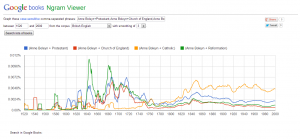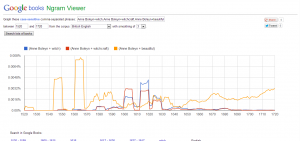Anne Boleyn was Henry VIII’s second and perhaps most controversial wife. Many believe that she alone was fully responsible for the King’s break from Rome and the Pope; that his love for her was so great he would let his country fall to ruin. However, Anne was not the main factor in Henry’s decision to defy the Pope. In fact, some historians argue that the break with the Catholic Church would have happened with or without her, but Henry’s feelings for her provided a catalyst for the break.
From the time of her arrival at court until a short while before her death, Anne Boleyn had a strange sort of power over the King of England. He was completely infatuated with her, and she knew how to play that to her advantage. She promised him sons, something Catherine of Aragon had failed to give him even after years of marriage. She was young and beautiful and she was the only woman he courted who refused to become his mistress, insisting she would sleep with her husband and no one else, not even a king.
View Anne Boleyn’s Life and Rise to Power in a larger map
Anne was brought up well, as were most ladies of the time. She was sent from home at a young age to learn court manners and graces, as well as languages and other things that would help her find a good husband when the time came. Spending so much of her youth in France, she had a fondness for the country and its people, something that put her in even more direct opposition with Queen Catherine, the daughter of Spanish royalty. Henry was known for often changing alliances between France and Spain, and when he was courting Anne his attitude toward Spain and the Holy Roman Empire cooled considerably, while England’s relationship with France grew ever-stronger. Anne knew the French king personally, having been his wife’s attendant for many years. It is interesting to note that Henry created a peerage just for Anne; the title of the Marquess of Pembroke was, in its time, the only hereditary female peerage in the world. This happened before they were married, and indeed before they knew they would even be able to marry. Henry thought very highly of Anne, and she of him.
Henry’s letters to Anne, likely written in the late 1520’s, show just how much influence she already had over the king. He writes at length of hope and love, calling her his mistress and he, her servant. While there are no records of Anne’s letters back to him, though we can assume that they were filled with just as much ardor and fancy prose. Henry writes much about “absence” and “lack”, referring the the long lengths of time Anne spent away from court, something he hated but her family believed to be a good thing (they were clearly proponents of “absence makes the heart grow fonder”). “Time” and “trust” were also big factors in his letters. Henry and Anne waited almost a decade until they were finally able to marry; they would have been quite familiar with waiting and “trusting in God”, as they both-Henry especially- believed that Henry’s first marriage was cursed by God and he was absolutely doing the right thing by putting Catherine aside for Anne.
Anne Boleyn has long been associated with the English Reformation. In fact, many believe that she was the first Protestant Queen of England and that she alone converted Henry from Catholicism. However, both Henry and Anne identified as Catholics their entire lives, albeit Catholics who did not agree with the Pope or the Church. Henry was vehemently against Martin Luther and Lutheranism, going so far as to burn Lutheran heretics at the stake for their beliefs. Anne was more open-minded; she owned a copy of the Bible translated into English and encouraged her ladies and other servants to read it whenever they wished. She was also notorious for openly reading books that Henry himself had banned, for fear they would incite a Lutheran uprising. She was even able to convince Henry, the man who had ordered the books banned, to read some of them. While he did not always agree with their teachings, Anne was never punished for flouting his laws. Her opinion mattered very much to him, something that was not seen again until he married Catherine Parr, his sixth wife and another Protestant sympathizer, when he was close to death and less able to rule his country. Anne’s name will always be tied to the Reformation; she was an intelligent woman who had a good head for both politics and religion and absolutely knew how to play the game. Even today she is one of the women most associated with bringing about one of the most important changes in English history.
The faction of staunch Catholics at court loathed Anne, seeing her as a threat not only to the One True Faith, but also to the kingdom itself as she was not popular with the common people, who believed her to be a witch, or a whore who had witchcraft at her disposal. They started rumors that she had a sixth finger on one hand, and that she made pacts with the devil. These rumors persist even today; many see Anne Boleyn as her opponents painted her almost 500 years ago.

The First Act of Succession was passed in 1534, before the birth of Anne’s daughter Elizabeth. Assumed to be a boy, it was not unreasonable for Henry to want the throne to pass to his newborn son by Anne rather than his Mary, his daughter by Catherine of Aragon. However, this Act was still in place after Elizabeth’s birth, and she was Henry’s one true heir until the Second Act of Succession was passed a few months after Anne’s trial and execution, removing both Elizabeth and Mary from the line of succession to the throne. While Anne had disappointed him greatly it would take two miscarriages, a dozen counts of treason and adultery, another woman, an execution and rumors of Elizabeth’s true parentage for Henry to remove Anne’s daughter from the line of succession It is interesting that the word “son” is used so many times in the text; this was at a time when kings were assured that every child would be a son. Henry already had a daughter whom, according to the professionals, would definitely be a boy, yet he still seemed certain that Anne’s child would be a son. Female children could inherit the throne (and indeed, both Mary and Elizabeth ruled after their father’s death), but in those days it was almost unheard of and Henry was desperate to be succeeded by a male heir. It is a known fact that Anne promised him a son and so it seems a miracle that he did not strike down the Act of Succession the minute Elizabeth- his long awaited for “son”- was born.
View Royal Progress of 1535 in a larger map
It is interesting to think that even so close to her downfall, Anne was still in Henry’s good graces. By the time of the royal progress in 1535 Henry’s attentions had already begun to stray again; Anne had given birth to a healthy daughter, but the sons she had promised were stillborn. Yet they still put up a united front and on this journey they made a point to inspect at least one of the manors held by the Duke of Suffolk; Henry’s longtime friend. The manor was being inspected before it was turned over to the Crown; Suffolk had fallen out of favor not because he married Henry’s recently widowed sister in secret and without the permission of the King (which he did), but because he was an outspoken opponent of Henry’s marriage to Anne. Many people attribute Henry’s continuing coldness towards his old friend as wounded pride and nothing really to do with Anne, but the fact of the matter is, once Anne had been executed Suffolk returned to court and to favor.
Both supporters and opponents of the doomed Queen recognize that she was an incredibly influential woman who brought about a lot of changes in her country. It is doubtful that anyone else would have had so much affect on the king, that he would divorce a woman with the strength of two royal powers at her back, to marry what amounted to a commoner with no real political alliances to another country. Their courtship and marriage was previously unheard of, and has since been unmatched in terms of passion and foolishness.
References:
Ives, E. W. The Life and Death of Anne Boleyn: ‘the Most Happy’ Malden, MA: Blackwell Pub., 2004. Print.
http://onthetudortrail.com/Blog/anne-boleyn-places/palaces-and-houses/
http://www.luminarium.org/encyclopedia/firstactofsuccession.htm
http://www.gutenberg.org/files/32155/32155-h/32155-h.htm
—
Preservation: For the preservation of this project, I will of course save a copy to my computer and to a thumb drive. Through the blog, it will be saved to a server (perhaps multiple servers), and I believe as long as Google Maps continues to work, this blog post will be view able for the foreseeable future. It might also be a good idea to post it in various places and on various other blogs, as an OnMason blog is not as prolific as others and might have a shorter lifespan, as well as a more limited audience, seeing as it’s a blog for one specific college.



I noticed that it’s hard to find your website in google, i found it on 17th spot, you should get some quality backlinks to rank it in google and increase traffic. I had the same problem with my website, your should search in google for – insane google ranking boost – it helped me a lot